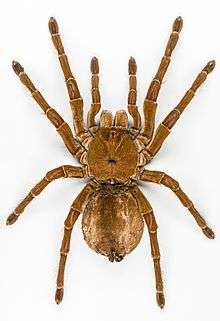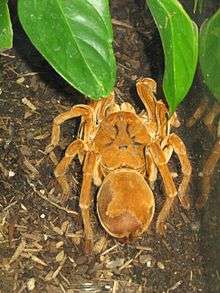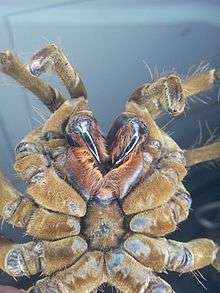Goliath birdeater
The Goliath birdeater (Theraphosa blondi) belongs to the tarantula family Theraphosidae. Found in northern South America, it is the largest spider in the world by mass (175g) and size (10.41cm), but it is second to the giant huntsman spider by leg span.[1] It is also called the Goliath bird-eating spider; the practice of calling theraphosids "bird-eating" derives from an early 18th-century copper engraving by Maria Sibylla Merian that shows one eating a hummingbird. Despite the spider's name, it only rarely preys on birds.[2]
| Goliath birdeater | |
|---|---|
 | |
| Theraphosa blondi, adult female | |
| Scientific classification | |
| Kingdom: | Animalia |
| Phylum: | Arthropoda |
| Subphylum: | Chelicerata |
| Class: | Arachnida |
| Order: | Araneae |
| Infraorder: | Mygalomorphae |
| Family: | Theraphosidae |
| Genus: | Theraphosa |
| Species: | T. blondi |
| Binomial name | |
| Theraphosa blondi (Latreille, 1804) | |
| Synonyms | |
| |
Description

These spiders can have a legspan up to 30cm, a body length of up to 13cm and can weigh up to 175g .[3] Birdeaters are one of the few tarantula species that lack tibial spurs, located on the first pair of legs of most adult males. They are mostly tan to light brown and golden-hued.
Lifecycle
Unlike other species of spider/tarantula, females do not eat the males during mating. Females mature in 3-6 years and have an average lifespan of 15 to 25 years. Males die soon after maturity and have a lifespan of 3-6 years. Colors range from dark to light brown with faint markings on the legs. Birdeaters have hair on their bodies, abdomens, and legs. The female lays 100 to 200 eggs, which hatch into spiderlings within 6-8 weeks.[4][5]
Behaviour
Defenses
In response to threats, Goliath birdeaters stridulate by rubbing setae on their pedipalps and legs.[6][7] Also when threatened, they rub their abdomen with their hind legs and release hairs that are a severe irritant to the skin and mucous membranes. These urticating hairs can be harmful to humans.[7]
Like all tarantulas, T. blondi spiders have fangs large enough (2–4 cm or 0.79–1.57 in) to break the skin of a human. They carry venom in their fangs and have been known to bite when threatened, but the venom is relatively harmless and its effects are comparable to those of a wasp's sting. Tarantulas generally bite humans only in self defense, and these bites do not always result in envenomation (known as a "dry bite").[8]

Feeding
Despite its name, the Goliath birdeater only rarely actually preys on birds; in the wild, its diet consists primarily of other large arthropods, worms, and amphibians.[9] However, because of its size and opportunistic predatory behavior, this species commonly kills and consumes a variety of insects and small terrestrial vertebrates. They do not consume their prey "in public" rather, they drag it back to their burrow and begin the digesting process. They do this by liquifying the insides of their prey and proceed to suck it dry. [10] In the wild, T. blondi has been observed feeding on rodents, frogs, toads, lizards, and even snakes.[11]
Distribution and habitat
The Goliath birdeater is native to the upland rain forest regions of northern South America: Suriname, Guyana, French Guiana, northern Brazil, and southern Venezuela. Most noticeable in the Amazon rainforest, the spider is terrestrial, living in deep burrows, and is found commonly in marshy or swampy areas. It is a nocturnal species.[12] The spider is part of the local cuisine in northeastern South America, prepared by singeing off the urticating hairs and roasting it in banana leaves. The flavor has been described as "shrimplike".[13]
See also
- Giant huntsman spider, largest known spider in the world by leg span
- Mongolarachne jurassica, the largest known fossilised spider
- Cerbalus aravaensis, a huntsman spider found in Israel and Jordan
References
- World's biggest spider face-off - see which bug wins here Archived October 23, 2014, at the Wayback Machine
- Herzig, Volker; King, Glenn F. (2013). "The Neurotoxic Mode of Action of Venoms from the Spider Family Theraphosidae". In Nentwig, Wolfgang (ed.). Spider Ecophysiology. Springer. p. 203. ISBN 978-3-642-33989-9.
- Goliath Bird-Eating Spider Archived 2016-04-16 at the Wayback Machine, Arkive
- "Goliath Bird-Eater Spider". Spiders Worlds. Retrieved 11 November 2018.
- "Goliath Bird Eating Spider". Blue Planet Biomes. 2003. Archived from the original on 19 July 2018. Retrieved 11 November 2018.
- Perez-Miles, Fernando; Montes de Oca, Laura; Postiglioni, Rodrigo; Costa, Fernando G. (December 2005). "The stridulatory setae of Acanthoscurria suina (Araneae, Theraphosidae) and their possible role in sexual communication: an experimental approach" (PDF). Iheringia, Série Zoologia. 95 (4): 365–371. doi:10.1590/S0073-47212005000400004.
- Lewis, Tanya (18 October 2016). "Goliath Birdeater: Images of a Colossal Spider". Live Science. Retrieved 20 February 2017.
- "World's Biggest Spider - Goliath Birdeater Amazing Facts.. » Gban'S & You". Gban'S & You. 2020-06-21. Retrieved 2020-06-22.
- Lewis, Tanya (17 October 2014). "Goliath Encounter: Puppy-Sized Spider Surprises Scientist in Rainforest". Live Science. Archived from the original on 24 November 2017.
- National Geographic
- Menin, Marcelo; Rodrigues, Domingos De Jesus; de Azevedo, Clarissa Salette (October 2005). "Predation on amphibians by spiders (Arachnida, Araneae) in the Neotropical region". Phyllomedusa. 4 (1): 39–47. doi:10.11606/issn.2316-9079.v4i1p39-47. ISSN 1519-1397.
- Striffler, Boris F. (November 2005). "Life history of Goliath Birdeaters – Theraphosa apophysis and Theraphosa blondi (Araneae, Theraphosidae, Theraphosinae)" (PDF). Journal of the British Tarantula Society. 21 (1): 26–33. ISSN 0962-449X. Archived from the original (PDF) on 6 December 2013. Retrieved 10 September 2013.
- Dell'Amore, Christine (20 October 2014). "Puppy-Size Tarantula Found: Explaining World's Biggest Spider". National Geographic Blog. Archived from the original on 15 December 2018.
External links
| Wikimedia Commons has media related to Theraphosa blondi. |
| Wikispecies has information related to Theraphosa blondi |